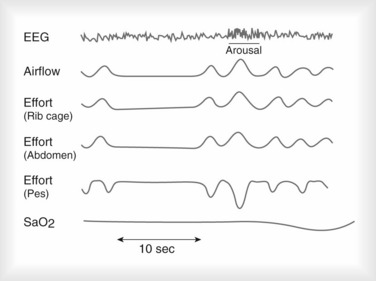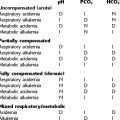CHAPTER 12 DISORDERS OF THE RESPIRATORY SYSTEM
PRETEST QUESTIONS
1. Pursed-lip breathing would be most beneficial in which of the following lung disorders?
2. On assessing a patient’s laboratory results, you notice a sputum culture that reveals a high eosinophil count. This is characteristic of which of the following pulmonary conditions?
3. Which lung condition is characterized by consolidation on chest films?
4. A 17-year-old asthmatic girl enters the emergency department in moderate respiratory distress. She states that the attack began about 1 h before she came to the emergency department. You would expect her ABG results to reveal
5. Which of the following causative organisms for pneumonia is characteristically seen in patients with acquired immunodeficiency syndrome (AIDS)?
6. The drug streptokinase is used to treat which of the following lung disorders?
REVIEW
I. Chronic Obstructive Pulmonary Disease (COPD)
IV. LOWER RESPIRATORY TRACT INFECTIONS
![]() Bronchoalveolar lavage (BAL) is a technique whereby sterile saline is instilled through a bronchoscope to a specific lung segment. The saline is then aspirated and collected for culturing. BAL is being used to help diagnose nosocomial pneumonia. Recently, it is being advocated for diagnosing ventilator-associated pneumonia (VAP). VAP is discussed in detail in Chapter 11 on ventilator management.
Bronchoalveolar lavage (BAL) is a technique whereby sterile saline is instilled through a bronchoscope to a specific lung segment. The saline is then aspirated and collected for culturing. BAL is being used to help diagnose nosocomial pneumonia. Recently, it is being advocated for diagnosing ventilator-associated pneumonia (VAP). VAP is discussed in detail in Chapter 11 on ventilator management.
CRT Exam Content Matrix: IB9o,t, IB10o,t, IC11
RRT Exam Content Matrix: IA10, IB9p,u, IB10q,v, IC13, IIIK8
POSTCHAPTER STUDY QUESTIONS
1. List three lung disorders classified as COPD.
2. List the common findings on the chest films of a patient with emphysema.
3. What PaO2 level should be maintained for a COPD patient with chronic hypoxemia?
4. List the clinical signs and symptoms of cor pulmonale.
5. How does O2 therapy help prevent or treat cor pulmonale?
6. The count of which type of WBC is characteristically elevated in the sputum and blood of a patient with asthma?
7. What aerosolized medication is used to treat P. carinii pneumonia?
8. List four causes of cardiogenic pulmonary edema.
9. List the signs and symptoms of pulmonary edema.
10. List the treatment modalities for pulmonary edema.
11. List the various causes of ARDS.
12. List the signs and symptoms of ARDS.
13. List treatment modalities for ARDS.
15. What is the immediate treatment for a tension pneumothorax?
16. What is the most effective method for treating obstructive sleep apnea?
17. List six variables that are measured during a sleep study.
Farzan S. A concise handbook of respiratory diseases, ed 4. Stamford, CT: Appleton & Lange; 1997.
Hess D, Respiratory care principles and practice, ed 1, Philadelphia, Saunders, 2002.
The Merck manual of medical information. Whitehouse Station, NJ: Merck, 1997.
Wilkins R, Dexter J. Respiratory disease, a case study approach to patient care, ed 3. Philadelphia: FA Davis; 2007.
Wilkins RL, Stoller JK, Kacmarek R. Egan’s fundamentals of respiratory care, ed 9. St Louis: Mosby; 2009.





